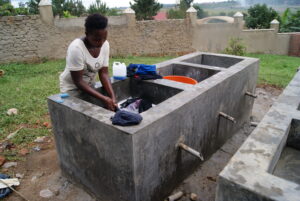WATER & SANITATION

Sanitation remains a substantial problem in Uganda because there remains a demand-side barrier preventing good hygiene: a lack of awareness about the importance of hygiene and handwashing. UNICEF has identified improvement in health-seeking behavior through addressing social norms at the community level is a critical area of intervention. However, hygienic habits are only part of the struggle in addressing sanitation, there must also be access to clean water and unfortunately, one of the most common deprivations for children under 5 is access to an improved water source, impacting the leading two deprivations: nutrition and health (M&U 2015). In recent years, child survival has improved yet there remains limited access to clean water and sanitation. In fact, approximately four of every 50 households have a handwashing facility (M&U 2015). The Central Region of Uganda has the second largest proportion of children deprived of an improved water source over the course of multiple years. Efforts to improve water sanitation and hygiene in aggregate – commonly referred to as WASH – have been circulating globally but implementation is slow in Uganda. A lack of awareness coupled with a slow drive for change perpetuates this cycle and for vulnerable children access is further limited since they often do not receive resources or instruction to develop healthy habits.
Water Security for our partner organizations specifically is a two-part challenge; firstly is lack of consistent access to safe water and second is the hazard flooding creates in the rainy season. Consistent access to water is a struggle for these organizations with high water bills causing water companies to shut off water occasionally, forcing a reliance on unsafe water from Lake Victoria for cooking, washing and cleaning. The water in Lake Victoria contains untreated sewage, pesticides, fuel, and waste, exacerbated by a growing population, specifically on the north side of the lake in Uganda (Arche Nova).
Current Projects
Water Security
To help improve water security for our partner organizations, ASA seeks funding for improvement of access to clean water. This includes installation of additional water pumps and improvement of existing pumps. Further, ASA seeks funding for the purchase of rain harvesting pumps.
It is well known that access to clean water can improve the health, safety and quality of life, but also reduce or eliminate illnesses caused by consuming unsafe and unsanitary water. When children are healthy, they miss less days of schooling, and are thus able to work towards achieving higher quality of life.
In the longer term, ASA hopes to lead our partner organizations to a state of greater self-sufficiency, and limited reliance of donor funds. Being able to harvest and store additional rain water and pump water will allow these organizations to increase the supply of water that can be used through-out the organizations. This will ultimately decrease the water bills, and allow funds to be used in a more efficient manner.


Latrines and Sanitation
Noah’s Ark latrine facilities are in need of updating to become more accessible, sanitary, and sustainable. Ease of access and mobility are a constant challenge for many of the children and the presence of physical barrier often determines their participation in activities, including the use of the restroom. It is often a difficult task requiring assistance from a teacher or volunteer since the latrines are located up a steep double set of stairs. Once up the stairs, the latrine is poorly lit and consists of a hole in the floor (in one latrine it is not even located in the center). There is no stability offered the children as they balance over the small hole with the current design.
There is a need to purchase a new latrine structure that is more accessible without the need for stairs, comfortable through the use of adaptive stances and support structures, and sanitary through ventilation and conversion of waste into fertilizer. The organization’s asset and income-generation program brings innovation to every aspect of Noah’s Ark’s programming and development.
The support of this project would immediately improve the site and well-being of the children living and growing at Noah’s Ark, while providing a sustainable income generation opportunity


